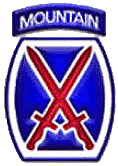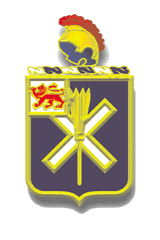

History of the "Chosin!" Battalion
∑ The 32nd Infantry Regiment was first organized on 7 August 1916, on the island of Oahu, Hawaii, from the elements of the 1st and 2nd Infantry Regiments. At its activation, it was know as "The Queenís Own" Regiment, a title bestowed by the last queen of Hawaii, Queen Liliuokalani.
∑ During World War I, units of this Regiment were used to escort German Prisoners being transferred to the United States from Hawaii. On 20 July, 1918, the 32nd was transferred to Camp Kearny, California, where it became a part of the 32nd Infantry Brigade, 16th Infantry Division. A short time later, many of its men were transferred to the 82nd Infantry and remained with this organization until it was demobilized in 1919.
∑ The 2nd Battalion was reactivated in October, 1939, by the transfer of men from the 7th Infantry Division, and on 1 July 1940, the remainder of the Regiment was reactivated as a part of the 7th Infantry Division, at Fort Ord, California. After the infamous Japanese attack on Pearl Harbor, the 32nd was moved into defensive positions along the West Coast.
∑ As the job became apparent, the troops began intensive training as a motorized unit at Camp San Luis Obispo, California. Vast maneuvers were held in the Mojave Desert to prepare the 32nd for participation in the defeat of Field Marshall Erwin Rommel, the Desert Fox, in North Africa. A change in Allied strategy, however, turned the 32nd Infantry overnight toward its historic role as a powerful striking force in amphibious assaults from the frozen wastes of the Arctic through the lush, steaming maze of tropical jungle.
∑ Rushed to the Aleutians in the spring of 1943, after the Japanese had landed on Attu, the Regiment played a major role in retaking American territory lost during World War II. It was in this first engagement against the enemy that a member of the 32nd became the 7th Divisionís first Medal of Honor winner. Private Joe P. Martinez, Company I, 32nd Infantry received our nationís highest military award for outstanding bravery. Seeing his unit pinned down by enemy automatic fire, he single handedly charged the enemy emplacement and destroyed it. While rallying the men he was mortally wounded.
∑ For action on the Attu, three companies of the 32nd received Distinguished Unit Citations. These companies were "E," "I," and "K."
∑ After their baptism of fire in the Aleutian campaign, the 32nd sailed to Hawaii for intensive training emphasizing amphibious landings and jungle fighting.
∑ On 1 February 1944, the 32nd assaulted the Kwajalein. During the five days, the 32nd, along with the 184th Regiment, eliminated all the enemy personnel on the island, with the exception of a few battle weary Japanese who surrendered.
∑ The Regiment returned to Hawaii on 14 February where it went through additional intensified jungle training for an expected invasion of Yap. Arriving at Eniwetok on 25 September 1944, the orders were changed and the 32nd joined General Douglas MacArthurís forces, spearheading the first landings on Leyte in the Philippines. . Fighting in the swamps, tropical jungles, and over rugged mountains, the 7th Division battled over 37 miles in 60 days of the bitterest fighting in the Pacific.
∑ The Regimentís last campaign of World War II started 1 April 1945 with the landing at Okinawa. During this battle, which ended 21 June, the 32nd won the nickname Spearhead because of its continuous attacks against the enemy. For two months the battle of Okinawa raged, with the men of this Regiment stubbornly and effectively beating down the enemy.
∑ V-J Day was a great day of rejoicing for the free world, but for the men of the 32nd, responsibility for preserving peace was the new job. After only three days of rest, the 32nd embarked for Korea to receive the surrender of the Japanese troops south of the 38th parallel. During its campaigns through the Pacific, the 32nd traveled 16,910 miles - more than any other regiment in any war, up to that time.
∑ During the Regimentís occupation stay in Korea, Infantrymen obtained a preview of their tour in the Korean War. Units of the 32nd Infantry rotated on outpost positions along the 38th Parallel. The troops formed a tight perimeter against south bound guerrilla bands and were assigned the mission of eliminating the wholesale movement of black market goods across the boundary.
∑ In December 1948, the 7th Infantry Division loaded on ships and sailed to Japan where its zone of occupation responsibility included almost half of the total land area of Japan. The 32nd replaced the 11th Airborne Division. During its stay in Japan the strength of the Regiment was almost half of its TO&&E strength.
∑ Then came June 1950. The Communists crossed the 38th Parallel taking Seoul and pushing all the way to the "Pusan Perimeter." The 32nd began immediate preparation for deployment.
∑ Intensive training for a proposed amphibious landing in Korea highlighted the training for the Regiment. A big problem faced the 32nd in the integration of several hundred ROK soldiers who were to fight along side of American troops. Demonstrations, sign language and a smattering of the Japanese language were used during the intensive military training. The ROKs were integrated at the squad level and introduced to the American "buddy" system in combat. American soldiers were responsible for the training and integration of the assigned ROKs. After six days of loading supplies and equipment, the 32nd loaded onto troopships and on 16 September 1950 set foot again on Korean soil, this time in the invasion of Inchon.
∑ The enemy, employing small arms, mortar, and tank fire, could not stop the moving 32nd who advanced north toward the Han River, the last natural barrier to Seoul. The Buccaneers, in the cold morning hours of the 25th, crossed the Han River under intense enemy fire and captured their first objective at 1030, a dominating hill mass outside Seoul. Its capture provided the 32nd with sufficient momentum to gain all assigned objectives. With the capture of the surrounding heights overlooking and dominating the city, Marine elements were able to resume their advance. The Navy Distinguished Unit Citation went to the Buccaneers for relieving the pressure on the Marines.
∑ The Division was relieved of the responsibility for the Seoul area on 30 September and moved 350 miles overland, arriving in Pusan to begin training for another proposed landing, this time at Wonson, North Korea. Departing from Pusan harbor on 28 October, the mission of the 7th was changed to land at Iwon and advance to the Korean-Manchurian border.
∑ Landing at Iwon in the 29th, the 32nd moved quickly northward with the 1st Battalion on the east coast of the Chosin Reservoir and the 2nd and 3rd in the Fusan Reservoir area.
∑ At that point there were definite indications of Chinese Communist intervention. Information that three enemy divisions had arrived at Yudam-ni on 20 November reached intelligence personnel via prisoners of war. But on the ground no contact was made in the Chosin Reservoir area.
∑ On 29 November 1950, when the full force of the Chinese Communists struck the UN forces, the 2nd and 3rd Battalions stood their ground until UN elements further north moved to join the battle. Together all these UN elements made an orderly withdrawal from the Fusan area.
∑ The 1st Battalion on the east coast of the Chosin Reservoir was with elements of the 31st Infantry and the 1st Marines, who were cut off by the CCF. Only after long and bloody fighting did these forces work their way south to Koto-ri, and then to the Hungman perimeter. LTC Don C. Faith, 1st Battalion Commander, distinguished himself in this action. During the five day period from 27 November to 1 December 1950, he personally directed his troops across the ice-covered reservoir and continually placed himself with the forward elements of the Battalion. He was mortally wounded while attempting to destroy an enemy road block with hand grenades. For his heroic leadership, he was posthumously awarded the Medal of Honor.
∑ With the signing of the truce, The Buccaneers busied themselves in defensive preparations on the Korean peninsula, until it was reorganized and activated as the 1st Battalion 32nd Infantry Regiment for a short period.
∑ In 1978 the 1-32 Infantry was stood down as part of President Carter's effort to withdraw from Korea. Just prior to that, Colin Powell and Steven Silvasy served as battalion commanders while on their way to becoming general officers later on.
∑ On 15 February 1996 1st Battalion 32nd Infantry Regiment was activated as the only active Battalion of the 32nd Infantry Regiment as part of the 10th Mountain Division, Ft Drum, New York.
∑ Since then, 1st Battalion, 32nd Infantry regiment has maintained its proud heritage and remains a combat ready unit. The Battalion has participated in many training exercises as well as including Operation "Uphold Democracy" in Haiti and six-month rotation as a highly visible Multi National Force and Observer (MFO) peacekeeping mission in the Middle East.
∑ In May 2002 the battalion returned from a six-month rotation in Kosovo as part of Task Force Falcon. The deployment was part of Operation Joint Guardian.
∑ In August 2003 the battalion deployed in support of Operation Iraqi Freedom for a twelve month combat tour.
The soldiers of 1-32 Infantry continue their training and stand ready for the next operation upon which they will be called for. Chosin! Against all odds!